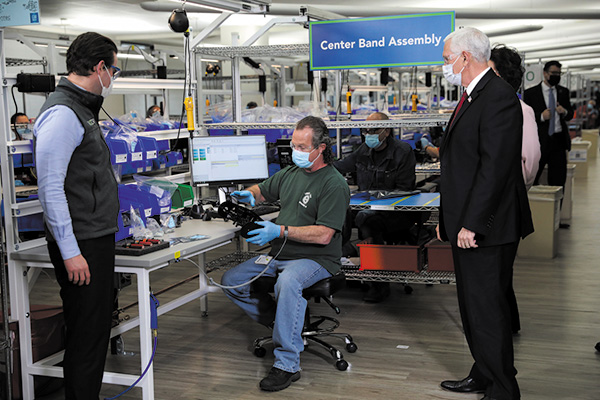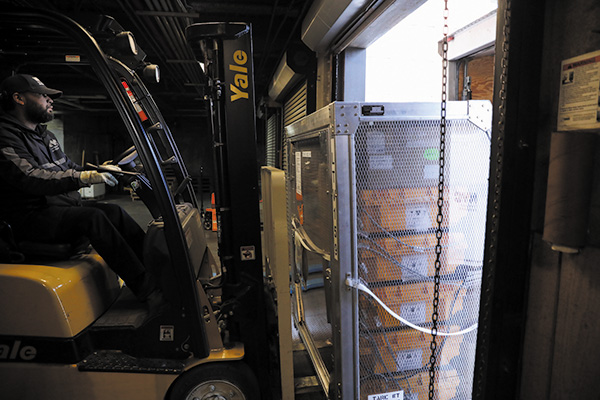
The covid-19 pandemic hit the world rather suddenly this year, catching the medical community unprepared for a crisis of such magnitude. Seemingly overnight, hospitals around the world were bombarded with highly contagious patients, many of whom required the aid of ventilators, also known as mechanical respirators, to continue breathing. According to Johns Hopkins’ Coronavirus Resource Center, at the time of writing the number of confirmed cases globally exceeded 7 million.
Unfortunately, hospitals in areas hardest hit by the virus quickly realized that they did not have enough of these life-saving machines to support all those who would need them. A report published by the Imperial College of London’s Covid-19 Response Team stated that of those hospitalized because of the virus, 30% will need the aid of a ventilator.
|
“We are happy to provide material to help fight covid-19.”
— Anton Soudakov, Chemours Co.
|
Furthermore, according to an article from the New England Journal of Medicine, in the United States alone, up to a million ventilators may be required to care for ill patients. When the article was published on April 30, it estimated that the number of ventilators with both partial and full capabilities in the U.S. was only about 160,000.
Some ventilator manufacturers—including GE Healthcare, Royal Philips and Hamilton Medical—stepped up to the challenge by upping their production numbers. GE Healthcare’s frequently asked questions webpage confirmed that the company has doubled its capacity and had plans to double it again by the end of June to address demand.
An April 8 press release from Philips stated that it had partnered with the U.S. government to increase production at its manufacturing sites in the country and planned to double production by May and quadruple it by the third quarter of 2020 for supply to the U.S. as well as global markets. Manufacturer Medtronic even responded to the call for increased production by sharing the design specifications of its PB560 machines with other medical supply companies.
Having been shut down by stay-at-home orders around the world, several vehicle manufacturers—including Ford, GM and Tesla—adapted their production lines to make ventilators to send to areas most affected by the virus. In a March 30 press release, Ford Motor Co. stated that it was set to pair up with GE Healthcare to produce 50,000 U.S. Food and Drug Administration-approved Airon Model A-E ventilators.
Ventilator OEMs and automakers weren’t the only ones to rise to the occasion. Lubricant formulators have also seized the opportunity to help. In fact, Wilmington, Delaware-based chemical company Chemours Co. is providing its Krytox brand greases to lubricate the ventilators being manufactured by Ford and GE Healthcare, according to Anton Soudakov, global marketing manager for the company. “We are happy to provide material to help fight covid-19,” he told Lubes’n’Greases.
Another player in the game of ventilator lubricants is Leeds, United Kingdom-based Rocol, which announced in a March 17 press release that it was hard at work producing greases designed specifically to lubricate critical parts in ventilators.

“Rocol was looking for ways to support the national effort [in the UK] to combat coronavirus,” Shaun Heys, marketing communications manager, told Lubes’n’Greases. “We all wanted to do something, and our small contribution was making sure that those who are new to manufacturing ventilators are able to do so properly, to provide correct information as well as a quality [lubrication] product.”
According to Soudakov, with a marked increase in ventilator manufacturing since the onslaught of the covid-19 pandemic, there is consequently an increased demand for the specialized lubricants that allow these life-saving machines to operate safely and effectively. “Demand has definitely gone up in this market sector,” he asserted.
However, according to David Westwood, engineering manager for Rocol, the market for ventilator lubricants is still a relatively small one and makes up a very small segment of application areas for oxygen-compatible greases. He explained that Rocol has seen a large amount of inquiries for its ventilator greases recently and has offered up a lot of information around the subject since the outbreak of coronavirus. “Demand has steadily increased, and we do have the capability to react to a large spike in demand,” he said.
Westwood indicated that Rocol’s main customers for its ventilator greases are pharmaceutical companies as well as ventilator manufacturers. The greases can be obtained from the company’s various distributors throughout the world.
|
“Ventilators need an oxygen-compatible lubricant. Most lubricants will outgas [release trapped gas] or vaporize when in oxygen-rich environments.”
— David Westwood, Rocol
|
Similarly, Chemours’ greases can be purchased directly from the company as well as through its global network of distributors, said Soudakov.
Ventilators Get Greased
Westwood stated that the lubricants used in most ventilators are typically greases, and the company’s most popular products for this particular application are its Rocol OT20 and RT15 greases. “Ventilators need an oxygen-compatible lubricant. Most lubricants will outgas [release trapped gas] or vaporize when in oxygen-rich environments.”
GE Healthcare’s Brian Lasiuk, chief technology officer, anesthesia and respiratory care, concurred, saying that it is vital for the machines’ safe operation that the lubricants used in ventilators be compatible with oxygen-rich environments. “We only use a lubricant
approved for O2 environments [in our ventilators], as unapproved lubricants may burn or explode in high O2 concentrations.”
Westwood explained that what keeps lubricants from outgassing is mainly the base stock used in the formulation. For example, Rocol’s OT20 and RT15 greases both utilize perfluoropolyether base stocks, which are ideal for application in ventilators because these colorless, fluorinated synthetic oils are nonreactive, nonflammable and safe for use in the presence of both oxygen and aggressive chemicals.
Robert Moffett, a research & development fellow working on Chemours’ Krytox and Fluoroguard Performance Lubricants, confirmed that Chemours’ medical-grade greases are also formulated using PFPE base stocks, as they do not degrade or otherwise react negatively with the elastomers, plastics, metals and other materials that make up a ventilator. PFPE oils are also biologically inert, said Moffett, meaning that they do not support microbial growth.
Both Chemours’ and Rocol’s greases, said Moffett and Westwood, include another important chemically and biologically inert component: a non-soap polytetrafluoroethylene thickener. PTFE thickeners, according to the National Lubricating Grease Institute’s website, are known for their good thermal stability, extended service life and ability to resist water, oxygen and other chemicals.
Westwood stated that only a small amount of grease is needed on the valves and the O-rings of a ventilator, a statement that was confirmed by GE’s Lasiuk: “We use only a very small film on some of the O-rings in our ventilators to help make a seal with components.”

There are several different designs and variations of mechanical respirators. But all of these machines do contain valves and seals to which grease should be applied to prevent excessive wear or “pick up.” Greasing the machine’s seals prevents them from drying out and cracking, which would keep the machine from functioning as it was designed. Rocol OT20 and RT15 can also be used to aid in the assembly process of such equipment, said Westwood.
|
“There are lots of OEM specifications and standards relating to the ventilators and the testing required, which then imply the lubricant must be of a certain quality and type.”
|
Lubricants used in ventilators are usually considered fill-for-life. “In this application, OT20 and RT15 are classed as ‘fit and forget’ lubricants,” said Westwood. “Therefore, re-lubrication would not be necessary.” However, if a ventilator is disassembled during repair, there is a chance that it may need to be re-lubricated before it is reassembled.
Not for Ventilators Alone
Oxygen-compatible greases, according to Westwood, can be used in other high-oxygen applications such as scuba diving equipment. “They [OT20 and RT15] can be used in many different applications and environments,” he told Lubes’n’Greases. “They are used in aggressive environments where other more conventional lubricants would not be suitable. They are suitable for vacuums. They are also good for chemical plants or anywhere chemicals can come in contact with the grease, as they are both chemically inert.”
The greases can also be used alongside other gases—such as chlorine and nitrous oxide—and aggressive cleaning fluids, said Westwood.
Furthermore, greases used in ventilators must offer the necessary lubricity at both very low and high temperatures. “OT20 is good in low-temperature environments down to minus 70 degrees Celsius,” said Westwood, “and RT15 is good in high-temperature environments up to 280 C.” According to the Krytox website, its greases also perform well in extreme temperatures.
Chemours’ Moffett said that outside of the medical industry, other industries most likely to use Krytox’s PFPE greases are in aviation and aerospace, automotive and industrial markets. For example, in the aviation and aerospace industry, the greases are particularly useful for lubricating the backup oxygen systems used in aircraft. They can also be used in fuel systems as well as rocket systems.
Ventilator Lubricant Standards
The majority of standards that greases must meet in order to be used in ventilators are set out by the original equipment manufacturers themselves, said Moffett. These standards do not point directly at the lubricants used, but instead have more to do with the ventilator itself. However, according to its website, Krytox Performance Lubricants have been tested by the West German Federal Institute for Materials Testing and approved for use in oxygen equipment used in medical, industrial and recreational applications.
“There isn’t a direct standard that the lubricant must be approved to,” explained Westwood. “However, there are lots of OEM specifications and standards relating to the ventilators and the testing required, which then imply the lubricant must be of a certain quality and type. The main aspects and requirements as far as the lubricant is concerned are regarding oxygen compatibility, VOCs [volatile organic compounds] and compatibility with seals.”
Syndey Moore is assistant editor for Lubes’n’Greases magazine. Contact her at Sydney@LubesnGreases.com.